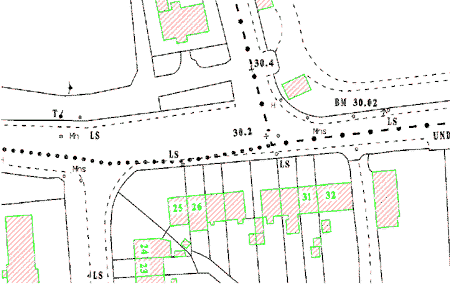The maps shown below are primarily intended to provide an example of what the map may look like. |
||
 Click on map for a larger view | Typical Road Map | The Road Map is very useful for locating towns and cities. Since many modern roads follow old roads and trails, the Road Map can not only direct you to the places you want to go, but it can give an idea of the ways your ancestors may have travelled. |
 Click on the image for a larger View | Place Maps. | Details shown on these types of maps may include buildings, lots, streets, alley ways, and street furniture (such as telephone kiosks, lamp standards, fire hydrants). These maps may also be known by other names, depending on where you live. |
 Click on map for a larger view | Aerial Photos | Aerial Photos are considered Maps, despite the fact that many find it hard to think of a photo as a map. :) These maps are at an approximate scale and measurements can be made on them with an accuracy good for that Close Enough job - and in addition you can actually see landmarks to help you outline a particular area. |
 Click on the map for a larger view | Typical Ordnance Survey Map | This is a copy of original Ordnance Survey Map 76, containing the numbers and boundaries of holdings as cited in Griffith's Primary Valuation. You also may utilize similar style of maps, known as Survey Maps, which shows more specific areas or individual properites. |
| No Map Available | Parcel Map | �Parcel map� means a map showing a division of land of four (4) or less parcels (with specific exceptions) as required by this ordinance, prepared in accordance with the provisions of this title and the Subdivision Map Act. |
| No Map Available | Plot Plan | �Plot plan� means a plan graphically describing proposed and existing buildings, structures, lot lines, and other required information submitted in conjunction with an application for discretionary or ministerial review and approval. |
| No Map Available | Tentative Map | �Tentative map� means a map made for the purpose of showing the design and improvements of a proposed subdivision and the existing conditions in and around it. You won't find many Tenative Maps in Genealogy. |
| No Map Available | Final Map | �Final map� means a map showing a subdivision for which a tentative and final map are required by the California Subdivision Map Act or this title, prepared in accordance with the provisions of this title and the California Subdivision Map Act, and designed to be recorded in the office of the County Recorder. You may not find many Final Maps in Genealogy either. |